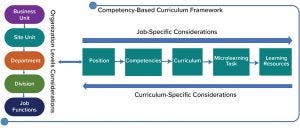A Framework for a Competency-Based CurriculumA Framework for a Competency-Based Curriculum
April 13, 2020

www.stock.adobe.com
Training departments in biopharmaceutical manufacturing facilities are at the forefront of ensuring that their employees are trained in accordance with regulatory compliance standards that govern the industry. More important, the purpose of training is to equip employees with relevant knowledge, skills, and abilities to perform their job functions competently. A competency-based curriculum has the potential to facilitate a training approach that addresses both the practical training needs and desired performance outcomes in a workplace.
Competency-Based Curriculum
Recently, I was involved in a curriculum review and redesign project at a pharmaceutical manufacturing organization. Early in the project, we agreed on a strategic objective that would see us align training curriculum with the organizational goals and performance outcomes. The redesign process led to an integrated compliance and competency-based curriculum framework that addressed both the regulatory and skills needs in the organization. My experience working on this project encouraged me to share some insights that may be applicable to similar curriculum redesign projects. As many of us who have worked in the pharmaceutical manufacturing industry know, standard operating procedures (SOPs) are the basis of training. Employee onboarding and retraining curriculums are designed around SOPs and other procedural documents to ensure that their work complies with regulatory standards. In effect, a curriculum is designed and developed around specific procedures and operations.
As a newcomer in the pharmaceutical industry from academia, I was taken aback by the subject-centered curriculum design that relies heavily on the read and understand training method. Coming into the industry, I expected a more practical approach to training given the main job functions in a manufacturing setting. As a result, this project led me to seek alternative curriculum design models that better address the functional competencies in manufacturing settings and desired performance outcomes.
What Is a Curriculum?
A curriculum comprises what we learn, how we learn it, and the desired performance outcomes aligned with those learning experiences. A curriculum can be defined broadly in many other ways but at its essence is part or some of all the sequenced and structured elements constituting specific learning experience and/or training.
For example, training materials, instructor-led training, on-the-job (OTJ) training, eLearning, assessments, and so on are components of a curriculum. A curriculum should integrate theory and practice seamlessly to produce desired performance outcomes. Thus, an instructionally sound curriculum should be structured and designed to address business goals and desired performance outcomes. Below, I have outlined some of the design considerations that I found useful as I sort to structure and develop an integrated compliance and competency based curriculum framework for my client.
Design Case Study
I started my project by considering both the product (results-oriented) and process (learning-oriented) models of curriculum development. My focus was on how best to integrate these models to address business needs and performance goals. The resulting framework enabled us to design a curriculum that was relevant to the specific needs of trainees at different levels of an organization structure. Furthermore, it enabled us to organize and chunk learning content to align with the organizational needs. Although this is not a unique approach to curriculum design, this framework reflects biopharmaceutical manufacturing organization structure. That said, the framework should be transferable to other similar organizations.

Figure 1: Curriculum by organizational levels and employee profiles
Organization Structure
The design considerations highlighted below follow a functional organization structure. The focus of the curriculum design is to align with organizational needs at different levels while emphasizing desired performance outcomes. The design would advertently support content sequencing and structuring of training using existing organizational structures. Figure 1 shows a flowchart of the framework and identifies specific design considerations.
Business Unit: Depending on the size of your organization, you can have more than one business unit. Examples include units for biologics, vaccines, and medical devices. Focus points at this level include the following:
required competencies at the business unit level (e.g., biologics core)
target audience (every employee)
expected performance outcome (knowing and understanding).
Site Units: At this level, identify all units that support the business unit. Examples include manufacturing, quality, technical services, and engineering etc. Focus points at this level include the following:
required competencies at the site units (e.g., quality core)
target audience (all positions under quality)
expected performance outcome (knowing and understanding).
Departments: Site units such as “quality” can include multiple departments such as quality assurance (QA), quality control (QC), and validation. Focus points at this level include the following:
required competencies at the department level (e.g., QA core)
target audience (all positions under the QA department)
expected performance outcome (knowing and understanding).
Divisions: Departments can be divided further into divisions. For example, a QA department can be divided into QA drug-product and QA drug-substance divisions. Focus points at this level include the following:
required competencies at the division level (e.g., gowning, aseptic techniques)
target audience (e.g., all QA positions in drug product)
expected performance outcome (knowing, understanding, and applying).
Job Functions: Each division may assign specific job functions to employees in specific job positions. For example, QA representative in the drug-product division duties can include reviewing batch records, ensuring that SOPs are current and effective, closing audit observations, and taking corrective and preventive actions (CAPA). Focus points at this level include the following:
required competencies at the job-function level (e.g., batch review)
target audience (e.g., all QA representatives performing functions)
expected performance outcome (knowing, understanding, applying, analyzing, and evaluating).
Competency-Based Approach
Designing a competency-based curriculum centers on trainees and their desired performance outcomes. As a result, curriculum should be designed to align learning interventions with employees’ job-specific functions. This approach leads to a curriculum that is specific to both organizational and performance needs. The following job specific considerations were useful in organizing learning content and designing relevant training for trainees in different job and organization levels.
Positions: Identify positions at all levels of your organizational structure. Examples include associate QA representative in drug-product primary, senior QA representative in drug-product secondary, and principal QA representative in drug substance.
Competencies: Identify knowledge, skills, and abilities required to perform job functions at each position level (e.g., QA representative in drug-product primary: product sampling and gowning).
Curriculum: Build a set of learning experiences needed for trainees to perform specific job functions.
Microlearning Task: For complex job functions, breaking down training into smaller learning activities can facilitate understanding and enhance the likelihood of knowledge retention.
Learning Content: SOPs and training materials created by subject matter experts (SMEs) are the backbone of curriculum design in biomanufacturing.
Training Essentials
SOPs, work instructions, written assessments, and performance evaluations are important elements of instructionally sound training. But they represent only learning content. More is needed to address learning strategies required to meet business needs and desired performance outcomes. In a process- and procedural-driven industry such as biopharmaceutical manufacturing, effective and efficient training is crucial to ensure high-quality production of safe and reliable drug products. One way to meet regulatory standards and performance needs is to design a competency-based curriculum. The framework outlined above can be a starting point when making design considerations to create a curriculum structure that address both compliance and competency needs. c
William Kanyi is a senior training specialist at Catalent Biologics, 1300 South Patterson Drive, Bloomington, IN 47401; [email protected].
You May Also Like






